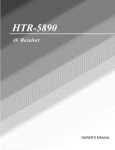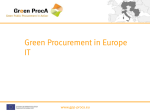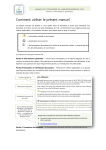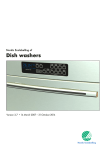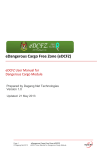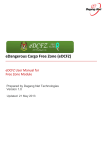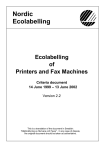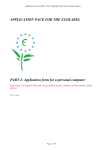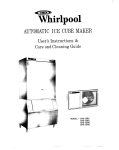Download Environmental criteria comparison between TED – The Eco
Transcript
Environmental criteria comparison between TED – The Eco Declaration, ECMA-370 for - Copiers / Printers and Multifunction Products and TCO Blue Angel Nordic Swan Version 1 / date: 2007-01-25 Page 1(10) Model: Version 1 / date: 2007-01-25 Page 2(10) Model: Environmental criteria comparison for Copiers/Printers/Multifunction Products Background This document was established to compare the environmental criteria in TED, The Eco Delaration, ECMA-370 with those found in certain Eco Label and Self Declarations systems for Multifunction Products/Copiers/Printers. The comparison is based on the status per February 2007 of these systems. Readers are requested to be aware that this comparison is an overview of the environmental criteria found in the investigated systems. For the exact criteria wording, the original documents have to be studied. This document contains comparison of: TED, The Eco Declaration, ECMA-370, 2nd edition, December 2006 compared with 1. TCO´99, Printers TCOF1075, 15st November 2006, version 2.1 (www.tcodevelopment.com) 2. Blue Angel RAL UZ 122, June 2006 (www.blauer-engel.de) 3. Nordic Swan. Version 4.1, 7 December 2006 (www.svanen.nu) Chapter: - Company Environmental Profile – TED / ECMA-370 compared with Blue Angel, Nordic Swan and TCO - Product Environmental Attributes - TED / ECMA-370 compared with Blue Angel, Nordic Swan and TCO - Requirements found in Blue Angel, Nordic Labeling and TCO but not in TED / ECMA-370 Key to the table of signs: ● Similar or more rigorous mandatory requirements. For exact wording, see original document. No requirements Version 1 / date: 2007-01-25 Page 3(10) Model: Annex A (normative) Company Environmental Profile This Annex is also provided as a separate file – ECMA-370-Annex-A.doc – that shall be used for the declarations. Provide URL if link doesn’t work. Item * =mandatory to fill in. Additional information regarding each item may be found under C6. C1 C1.1* Product recycling The company participates in a system or has its own system for collection and recycling of end of life products in countries where the company puts them on the market and where required (e.g. in line with EU WEEE directive 2002/96/EC) Battery recycling The company participates in a system or has its own system for collection and recycling of batteries in countries where the company puts products on the market (e.g. in line with EU battery directive 91/157/EEC) or pays eco tax / fee where required. Packaging recycling The company participates in a system or has its own system for collection and recycling of packaging material in countries where the company puts products on the market and where required (e.g. in line with EU packaging directive 94/62/EC) Blue Nordic TCO´ angel Swan 99 - Legal requirements C2 C2.1* C3 C3.1* ● ● - ● ● - - ● - - - ● ● - - - - ● ● ● - Market requirements C4 C4.1* C4.2* C4.3 C5 C5.1* C6 Environmental policy and environmental management The company has a documented environmental policy approved by the management. The company has an environmental management system covering: - Product development - Manufacturing If so certified according to: ISO 14001 EMAS Other as specified in C6 The company regularly publishes an environmental report. If so, it meets the recommendations of The Global Reporting Initiative Other as specified in C6 Recycling Information about the product, battery & packaging take back system (C1, C2, C3) is available in printed or electronic format. Additional information Version 1 / date: 2007-01-25 Page 4(10) Model: Annex B (normative) Product Environmental Attributes This Annex is also provided as a separate file – ECMA-370-Annex-B.doc – that shall be used for the declarations.Provide URL if link doesn’t work. Item * * =mandatory to fill in. Additional information regarding each item may be found under C6. Blue Nordic TCO´ angel Swan 99 - Legal requirements P1 P1.1* P1.2* P1.3* P1.4* P1.5* P1.6* P1.7* P1.8* P1.9* P2 P2.1* P2.2* P2.3* P3 P3.1* P3.2* P3.3* P3.4* Hazardous substances and preparations Products do not contain lead, cadmium, mercury, hexavalent chromium, polybrominated biphenyl (PBB) and polybrominated diphenyl ether (PBDE) as specified in EU 2002/95/EC and its amendments Products do not contain Asbestos (EU 76/769/EEC, amendment 1999/77/EC) Products do not contain Ozone Depleting Substances: Chlorofluorocarbons (CFC), hydrobromofluorocarbons (HBFC), hydrochlorofluorcarbons (HCFC), Halons, carbontetrachloride, 1,1,1-trichloroethane, methyl bromide (EU : Regulation (EC) No. 2037/2000, 2038/2000, 2039/2000) Products do not contain polychlorinated biphenyl (PCB), polychlorinated terphenyl (PCT), (EU 76/769/EEC) Products do not contain short chain chloroparaffins (SCCP) with 10-13 carbon atoms in the chain containing at least 48% per mass of chlorine in the SCCP as specified in Norwegian regulation relating to restrictions on the use of certain dangerous chemicals 20.12.2002 Textile and leather parts with direct skin contact do not contain Tri-(2,3,-dibromopropyl)-phosphate (TRIS), Tris-(aziridinyl)phosphineoxide (TEPA), polybrominated biphenyl (PBB) (EU 76/769/EEC) Textile and leather parts with direct skin contact do not contain Azo colourants that split aromatic amines as specified in EU 76/769/EEC, amendment 2003/3/EC Wooden parts do not contain arsenic and chromium as a wood preservation treatment as well as pentachlorophenol and derivatives (EU 76/769/EEC) Parts with direct and prolonged skin contact do not release nickel in concentrations higher than specified in 76/769/EEC, amendment 94/27/EEC Batteries If hazardous batteries (as defined in 91/157/EEC) are used in the product they are easily removable and labelled with the disposal and the substance logo (as defined in 91/157/EEC, 93/86/EEC) 2 If batteries are used in the product they do not contain mercury in concentrations higher than specified in 91/157/EEC If batteries are permanently installed in the product, information on the environmentally hazardous substances and safe removal method is listed in the user manual (91/157/EEC Electrical safety, EMC and connection to the telephone network The product meets the Low Voltage Directive (LVD) regarding electrical safety (73/23/EEC & 93/68/EEC) The product meets the EMC Directive regarding electromagnetic compatibility (89/336/EEC / 2004/108/EEC after June, 20th 2007 If product is intended for connection to a public telecom network or contains a radio transmitter, it meets the EU R&TTE Directive (1999/5/EC) The product is CE-marked and a Declaration of Conformity is available (93/68/EEC) Version 1 / date: 2007-01-25 Page 5(10) Model: ● ● ● - ● - - ● - - - - _ _ _ _ _ _ _ _ _ - - ● ● ● - - ● - ● - - - - - - - - - - Item * =mandatory to fill in. Additional information regarding each item may be found under C6. P4 P4.1* Consumable materials If a photo conductor (drum, belt etc.) is used in the product, it does not contain cadmium in concentrations higher than specified in (76/769/EEC and 91/338/EEC) If ink/toner is used in the product, it does not contain cadmium in concentrations higher than specified in (76/769/EEC and 91/338/EEC) If the ink/toner formulation/preparation is classified as hazardous according to EU Directive 1999/45/EC, and as amended, the product/packaging is labelled and a Material Safety Data Sheet (MSDS) in accordance with (99/45/EC & 2001/58/EC) is available. Product packaging The sum of the concentration levels of lead, cadmium, mercury, and hexavalent chromium present in packaging or packaging components does not exceed 0,01% by weight (94/62/EC). Plastic packaging material is marked according to ISO 11469 referring ISO 1043.(97/129/EEC) The product packaging material is free from CFC/HCFC. Treatment information Information for recyclers/treatment facilities (e.g. as requested by 2002/96/EC) is available. P4.2* P4.3* P5 P5.1* P5.2* P5.3* P6 P6.1* Blue Nordic TCO´ angel Swan 99 ● ● ● - - - ● ● ● ● - ● ● - ● ● ● ● ● - ● ● ● ● ● - ● ● ● - -- ● ● ● ● ● ● ● ● ● ● - Market requirements P7 P7.1* P7.2* P7.3* P7.4* P7.5 P7.6* P7.7* P7.8* P7.9. P7.10 P7.11* P7.12* P7.13* P7.14 P7.15 P7.16 Design Disassembly, recycling Parts that have to be treated separately are easily separable Plastic materials in covers/housing have no surface coating. Plastic parts >100g consist of one material or of easily separable materials. Plastic parts >25g have material codes according to ISO 11469 referring ISO 1043. Plastic parts are free from metal inlays or have inlays that can be removed with commonly available tools. Labels are easily separable. (This requirement does not apply to safety/regulatory labels). Product lifetime Upgrading can be done e.g. with processor, memory, cards or drives Upgrading can be done using commonly available tools Spare parts are available after end of production for: years Service is available after end of production for: years Material and substance requirements Product cover/housing material type: Electrical cable insulation material of power cables are halogen free (including PVC) Electrical cable insulation material of signal cables are halogen free (including PVC) All cover/housing plastic parts >25g are halogen free All printed circuit boards (without components) >25g are halogen free Chemical specifications of flame retardants in cover / housing plastic parts >25g according ISO 1043-4: Version 1 / date: 2007-01-25 Page 6(10) Model: Item P7.17 P7.18 P7.19 P7.20 P8 P8.1* P8.2* P8.3 P9 9.1 P9.2* P9.3 P10 P10.1 P10.2 * * =mandatory to fill in. Additional information regarding each item may be found under C6. Chemical specifications of flame retardants in printed circuit boards (without components) >25g according ISO 1043-4: Weight of recycled material in plastic parts is ? Plastic parts >25g are free from flame retardant substances/preparations above 0.1% classified as R45/46, R50/51/53 and R60/61 (67/548/EEC) Light sources are free from mercury If mercury is used specify: Number of lamps: and max. mercury content per lamp: mg Batteries Product does not contain batteries defined as hazardous according to 91/157/EEC Battery chemical composition: Batteries meet the requirements of the following voluntary program/s: Energy consumption For the product the following power levels or energy consumptions have been measured: Power level in volts at mode: On-max On-normal * On-idle Save 1 * Save 2 Off 1 * Off 2 * No load (External power supplies/charger plugged in but disconnected from the product) * TEC (Typical Energy Consumption per year) Information about the energy save function is provided with the product. The product meets the energy requirements of the following voluntary program/s: ENERGY STAR® MOU or others specify: Emissions Noise emission – Declared according to ISO 9296 Declared A-weighted sound power level LWAd (B) Idle * Operation * Other mode Declared A-weighted sound pressure level LpAm (dB) Idle * Operation * Other mode Measured according to: ISO7779, ECMA-74 or Other The product meets the acoustic noise requirements of the following voluntary program/s Version 1 / date: 2007-01-25 Page 7(10) Model: Blue Nordic TCO´ angel Swan 99 ● ● ● ● ● - - - ● ● - ● - ● - - - - ● ● ● ● ● ● ● ● ● ● ● ● ● ● ● - ● ● ● ● - ● ● ● - Item P10.3* P10.4 P10.5 P11 P11.1* P11.2* P11.3* P12 P12.1* P12.2* P12.3* P13 P13.1* P13.2* P13.3* P13.4* * * =mandatory to fill in. Additional information regarding each item may be found under C6. Chemical emissions from printing products Test performed according to ECMA-328 standard or other specified system (The test covers: dust, ozone, styrene, benzene or TVOC) The product meets the chemical emission requirements of a voluntary program/s which should be specified: Electromagnetic emissions Computer display meets the requirement for low frequency electromagnetic fields of the a voluntary program/s which should be specified Consumable materials for printing products A Material Safety Data Sheet (MSDS) is available for the ink/toner preparation, even if not legally required (see P4.3). Paper containing recycled fibres that meets the requirements of EN12281 can be used. 2-sided (duplex) printing/copying is an integrated product function. Ergonomics for computing products The computer system meets the ergonomic requirements of EN 29241-3, -7, -8 for CRT displays and EN-ISO13406-2 for flat panel displays. The product keyboard meets the requirements of ISO 9995 and EN 29241-4. The computer input device meets the requirements of ISO 9241-9. Packaging and documentation Product packaging material type and weight Product plastic packaging is halogen free (including PVC) User and product documentation do not contain chlorine bleached paper User and product documentation contain recycled paper Version 1 / date: 2007-01-25 Page 8(10) Model: Blue Nordic TCO´ angel Swan 99 ● ● ● - ● - - - ● ● ● ● ● ● ● - - - - - - ● ● - ● - - Requirements found in Blue Angel, EPEAT, EU Flower, Nordic Labeling and TCO but not in TED / ECMA-370 Item 1,1 1,2 2,1 2,2 2,3 2,4 2,5 3,4 3,5 * * =mandatory to fill in. Additional information regarding each item may be found under C6. Requirements not found in TED The printer shall be certified in accordance with EN 60 950. The printer should meet the European requirements for radio interference in accordance with standard EN 55 022, Limit Class B. 2. Controls shall be placed so that they can easily be reached by, for example, a short person or a person sitting in a wheelchair. 3. The size, shape and surface of controls shall be designed so that they are easily grasped when they are used as intended. 4. Controls operated by-keys shall have an operating force and a travel characteristic. The operating force shall not exceed 2.0 Newton. Touch-sensitive keys are not recommended. 5. Controls shall be located (grouped), designed and marked in a way that is logical for their intended use. 6. Legends o006E operating controls shall be easy detectable by use of contrast and symbols. It shall be possible to arrange controls with tactile symbols (such as Braille for visually disabled persons). 7. Controls shall be marked so that their settings can be easily identified by touch. 8. Status information on displays should enable the user to perforrn perceptual tasks effectively, efficiently and with satisfaction. 9. Mechanism employing latches for opening and closing shall not require the simultaneous use of two hands. 10. Handles or cut-outs for opening and closing shall not have sharp edges or pose a risk of compressing the fingers. 1. Signals from the basic system (apart from the application program), such as alarms, warnings, status lamps and error messages, shall have the following characteristics: - Alternative forms - auditory, visual or tactile - shall be available, allowing both visually and hearing impaired persons to adapt the signalling to their perceptive characteristics. - The volume, and if possible also the pitch and frequency, of auditory output shall be adjustable. - Visual signals shall be placed where they are easily perceived. 2. Warnings and similar alert messages must remain stable for a sufficiently long time to be noticed by the user. One way of avoiding problems is to let the message remain until it has been acknowledged and dismissed by the user. 3. It shall be possible to show alarms from the printer on the display of the workstation. The printer shall be capable of operating while placed against a wall, without the need to move it for normal use and maintenance. It shall be easy and safe to gain legitimate access into the printer, without fingers or hands being squeezed or cut, and in the case of a paper jam, without erasing information that may be stored electronically in the printer memory. The printer shall have a self-test function for fault finding, i.e. for assisting the user to solve the problem. Alternating electric fields: Band I: 5 Hz to 2 kHz, ≤ 10 V/m, measured at 50 cm in front of the printer. Band II: 2 kHz to 400 kHz, ≤ 1.0 Wm, measured at 50 cm around the printer. Alternating magnetic fields Band I: 5 Hz to 2 kHz, ≤ 200 nT, measured at 50 cm around the printer. Band II: 2 kHz to 400 kHz, ≤ 25 nT, measured at 50 cm around the printer. Version 1 / date: 2007-01-25 Page 9(10) Model: Blue Nordic TCO´ angel Swan 99 - - ● ● - - ● ● ● ● ● ● ● - - ● ● ● ● ● ● ● - - ● ● - - ● - - ● ● - - ● Item R5 R6 R20 * * =mandatory to fill in. Additional information regarding each item may be found under C6. Blue Nordic TCO´ angel Swan 99 The variety of materials used for plastic components of similar functions must be limited to one polymer or polymer blends. ● At least one part over 25 gram must be made of reused plastic or recycled plastic (post-consumer recycling). ● ● The following information must be specified in user information: ● - Recommendation that the machine be turned off when not in use. ● - Instructions on the positioning of the machine. ● ● - Information about the return system for recycling combined toner cartridges. ● ● - Information on disposal of used OPC kit/photosensitive drums, toner containers and containers for used toner. ● - Print capacity (copies per minute and copying volume per year or month). ● - Recommendation that ecolabelled paper be used. ● In the case of machines with a sound power level of more than 63 dB Lwad during operation and 40 dB Lwad in standby, the manufacturer should recommend that the machine be located in a room in which no employee has his/her work station. ● - Information that VOC should not exceed 5% by weight in the recommended ink. ● - Warranty period. The following technical information must be specified in the service manual: - A specification of how frequently ozone filters, drums and heat rollers etc require replacement. 3,1,1 3,1,14 3,1,4 3,2,1,3 3,2,2,3 3,2,2,2 3,2,2,4 3,4 3,5 4 Reusable parts that meet all relevant requirements shall be used with preference. Documents on effective disassembly, modules and the substances requiring selective treatment, components and consumables will be made available, if required, to the contracted companies. Batteries can be replaced at the end of their useful life without needing to exchange the entire printed circuit board or similar parts Toner modules and containers must be sealed so as to prevent toner dust from escaping during storage and transport. Azo dyes (dyestuffs or pigments) that might release carcinogenic aromatic amines appearing on the list of aromatic amines in Directive 2002/61/EC (see also TRGS 614) may not be used in toners and inks. No substances may be added to toners and inks which contain mercury, lead, nickel or chromium-VI-compounds as constituents. Exempted are high molecular weight complex nickel compounds as colorants. Only those substances may be added as active biocides to inks which are listed as so-called existing substances in Appendix II to Commission Regulation EC 2032/2003 amended by Regulation EC 1048/200512. The use of new (non-listed) active substances would require approval according to the Biozidgesetz (Biocidal Products Act). The criteria for energy consumption within the Blue angel are measured and calculated in relation to time for certain process e.g. operating mode, stand by or warming up. This differs a lot from other systems and is therefore not comparable. The criteria for noise emissions differs to common standard e.g. noise are set in relationship to printed page per minute. The following information must be specified in user information: - If applicable, information on the yield of the toner - Instructions for proper handling of toner modules - Instructions for proper product installation with regard to substance emissions - Noise emission data given as declared sound power level in the individual operating modes The plastic is free from fluoroorganic additives Key to the above table: ● Similar or more rigorous mandatory requirements. For exact wording, see original document - No requirements Notes: Note 1. This liste may note be complete, for details and exact wording se original documents Note 2. Certain criteria directly connected to applications procedure and system appurtenant have been excluded Version 1 / date: 2007-01-25 Page 10(10) Model: ● ● ● - - ● - - ● ● - - ● - - ● - - ● - - ● - - - ● - -












